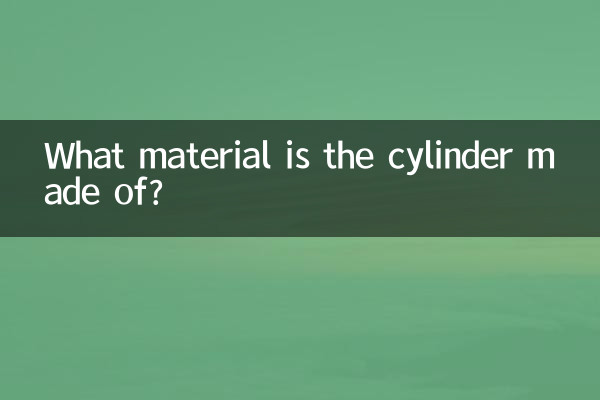What material is the cylinder made of?
As the core component of the hydraulic system, the material selection of the cylinder is directly related to its performance and service life. This article will combine the hot topics and hot content on the Internet in the past 10 days to introduce in detail the common materials, characteristics and applicable scenarios of oil cylinders, and use structured data to help readers quickly understand.
1. Basic concept of oil cylinder

The oil cylinder is an actuator in the hydraulic system that converts hydraulic energy into mechanical energy. It is widely used in engineering machinery, aerospace, shipbuilding and other fields. Its core materials need to have high strength, corrosion resistance, wear resistance and other properties.
2. Common materials and characteristics of oil cylinders
| Material type | characteristic | Applicable scenarios |
|---|---|---|
| Carbon steel (such as 45# steel) | High strength, low cost, easy to process | General hydraulic systems, construction machinery |
| Stainless steel (such as 304, 316) | Corrosion resistance and oxidation resistance | Food machinery, chemical equipment |
| Aluminum alloy | Light weight and good thermal conductivity | Aerospace, light equipment |
| Cast iron (such as HT250) | Wear-resistant and shock-absorbing properties | Heavy machinery, mining equipment |
3. Recent hot topics: innovation of cylinder materials
In the past 10 days, discussions on cylinder materials on the entire Internet have mainly focused on the following hot spots:
1.Nano coating technology: Improving the wear resistance and corrosion resistance of oil cylinders through surface treatment has become a new trend in the industry.
2.Composite material applications: The trial use of lightweight materials such as carbon fiber in high-end fields has attracted attention.
3.Environmentally friendly materials: The growing demand for pollution-free and recyclable materials has promoted the upgrading of cylinder materials.
4. Suggestions for selecting cylinder materials
When selecting materials based on actual needs, the following factors need to be considered:
| Considerations | Recommended materials |
|---|---|
| high load | Carbon steel, alloy steel |
| corrosive environment | Stainless steel, plated materials |
| Lightweight | Aluminum alloy, titanium alloy |
| cost control | carbon steel, cast iron |
5. Future development trends
With the advancement of technology, cylinder materials will develop in the direction of high performance, lightweight and environmental protection. For example:
1.high strength alloy: Improve the load-bearing capacity and service life of the oil cylinder.
2.smart materials: Materials with self-healing functions may become a research hotspot.
3.green manufacturing: Reduce carbon emissions during material production.
Summary: The material selection of the cylinder needs to be combined with the specific application scenario and balance performance and cost. In the future, the application of new materials and new technologies will further expand the potential of cylinders.

check the details

check the details